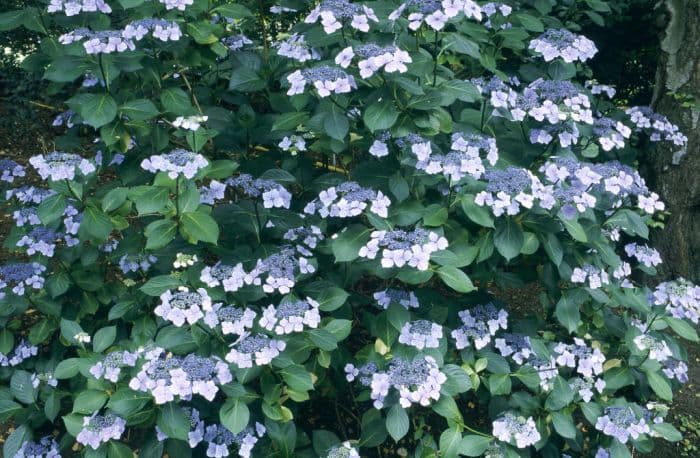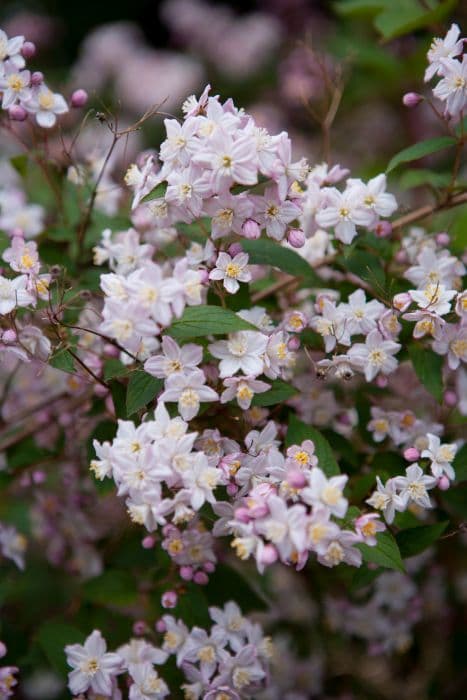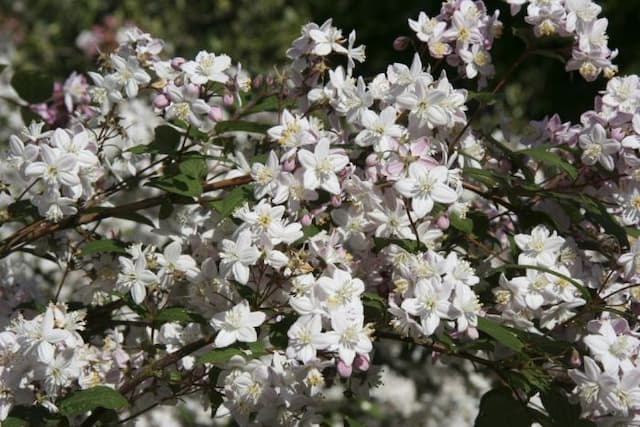Blue Wave Hydrangea Hydrangea macrophylla 'Mariesii Perfecta' (L)

ABOUT
The 'Mariesii Perfecta' hydrangea is a stunning ornamental plant known for its large, round flower clusters that showcase a range of colors from blue to pink, depending on the soil's acidity. These flowers appear in early summer and continue to enchant through the fall. Each cluster is composed of numerous small blooms that are tightly packed together, creating a dense, pom-pom like effect. The plant has lush, dark green leaves that are broadly ovate with pointed tips, providing a dramatic backdrop for the vibrant blooms. The leaves are characteristically toothed at the edges, adding texture to the plant's overall appearance. The flowers of this hydrangea are especially prominent, with the outer ring of blooms typically larger and more colorful, evolved to attract pollinators while the smaller blooms inside are fertile. This plant is often used as a focal point in gardens due to its showy nature.
About this plant
 Names
NamesFamily
Hydrangeaceae.
Synonyms
Bigleaf Hydrangea, French Hydrangea, Lacecap Hydrangea, Florist's Hydrangea, Garden Hydrangea, Blue Hydrangea, Pink Hydrangea, Hortensia.
Common names
Hydrangea macrophylla var. normalis, Hydrangea macrophylla var. otaksa, Hydrangea macrophylla f. normalis, Hydrangea macrophylla subsp. serrata.
 Toxicity
ToxicityTo humans
The common name of Hydrangea macrophylla 'Mariesii Perfecta' is bigleaf hydrangea. Bigleaf hydrangea is considered mildly toxic to humans if ingested. The plant contains compounds called cyanogenic glycosides, which can release hydrogen cyanide when chewed or digested. Symptoms of poisoning may include stomach upset, vomiting, and diarrhea. Ingesting large quantities could potentially lead to more serious symptoms such as dizziness, confusion, increased heart rate, and convulsions, but such severe cases are rare.
To pets
The common name of Hydrangea macrophylla 'Mariesii Perfecta' is bigleaf hydrangea. Bigleaf hydrangea is toxic to pets, including dogs and cats. The plant contains cyanogenic glycosides, which can release hydrogen cyanide when the plant parts are chewed and ingested. Symptoms of poisoning in pets might include vomiting, diarrhea, lethargy, abdominal pain, and depression. In severe cases, it may lead to more serious symptoms like labored breathing, seizures, and coma, especially if large amounts are consumed. Pet owners are advised to prevent their pets from ingesting this plant.
 Characteristics
CharacteristicsLife cycle
Perennials
Foliage type
Deciduous
Color of leaves
Varies
Flower color
Varies
Height
4 feet (1.2 meters)
Spread
4 feet (1.2 meters)
Plant type
Shrub
Hardiness zones
5
Native area
Japan
Benefits
 General Benefits
General Benefits- Aesthetic Appeal: Hydrangea macrophylla 'Mariesii Perfecta', commonly known as Blue Hydrangea, offers stunning blue to pink flowers depending on soil pH, adding beauty to gardens and landscapes.
- Versatile Landscaping: The plant can be used for a variety of landscaping purposes, such as hedge borders, foundation plantings, or as stunning focal points in garden beds.
- Seasonal Interest: Blue Hydrangeas have a long blooming period from early summer to late fall, providing extended color and interest within the garden.
- Ease of Care: They are relatively easy to grow and maintain, adaptable to a range of soil types, though they prefer moist, well-drained environments.
- Wildlife Attraction: The flowers attract pollinators like bees and butterflies, contributing to the ecological health of the garden ecosystem.
- Privacy and Screening: When planted in groups or as hedges, Blue Hydrangeas can provide privacy and screen unsightly views throughout the growing season.
- Cutting Garden Plant: The flowers are excellent for cutting and creating floral arrangements, maintaining their color and shape well when cut.
- Suitable for Containers: These hydrangeas can be grown in containers, allowing them to be featured on patios, balconies, or other spaces where garden soil is not available.
- Seasonal Foliage Color: In addition to flowers, Blue Hydrangeas offer attractive foliage which can turn to striking shades of yellow, orange, or red in the fall.
- Cultural Significance: Hydrangeas have been celebrated in art and culture and may signify heartfelt emotions, gratitude, and sometimes even boastfulness in the language of flowers.
 Medical Properties
Medical PropertiesThis plant is not used for medical purposes.
 Air-purifying Qualities
Air-purifying QualitiesThis plant is not specifically known for air purifying qualities.
 Other Uses
Other Uses- Decomposable confetti: The dried petals of Hydrangea can be crumbled and used as natural, biodegradable confetti for eco-friendly celebrations.
- Photography backdrop: Large Hydrangea bushes in full bloom can provide a stunning and colorful backdrop for portrait and wedding photography.
- Craft material: The robust flowers of the Hydrangea can be dried and used in crafting, such as in wreath making or to create flower arrangements that don't wilt.
- Dye source: The petals of the Hydrangea can yield natural dyes in varied colors like pink, blue, and purple, depending on the soil pH and the presence of aluminum ions.
- Indicator of soil pH: Gardeners can use the color change of Hydrangea flowers as a natural indicator of the pH level of their soil, without needing a pH test kit.
- Culinary presentation: Although not for consumption, Hydrangea flowers can be used on food platters for decorative purposes at upscale events or in food photography.
- Book pressing: The flat nature of Hydrangea blossoms makes them ideal for pressing and using in the age-old art of book flower pressing.
- Garden stepping stones: Placement of Hydrangea leaves in wet cement when making garden stepping stones can create beautiful leaf patterns upon removal.
- Ritualistic decor: In some cultures, Hydrangeas are used in various ceremonies and rituals for their symbolic meanings, like heartfelt emotions or gratitude.
- Frost protection: The cut flowers of Hydrangeas can be placed over other plants to provide a light degree of frost protection during unexpected cold snaps.
Interesting Facts
 Feng Shui
Feng ShuiThe Hydrangea is not used in Feng Shui practice.
 Zodiac Sign Compitability
Zodiac Sign CompitabilityThe Hydrangea is not used in astrology practice.
 Plant Symbolism
Plant Symbolism- Heartfelt Emotions - Hydrangeas are often associated with showcasing genuine emotion and, more specifically, gratitude for being understood by another.
- Apology - With its bountiful and lush blooms, the hydrangea is also a symbol of apology, or a way to express regret and ask for forgiveness.
- Vanity and Boastfulness - This stems from the plant's ability to produce a large number of flowers, but relatively few seeds.
- Gratitude for Understanding - This blue hydrangea specifically signifies a deep and heartfelt appreciation for comprehension and empathy from others.
- Abundance - The lushness and voluminous nature of the blooms represent abundance and prosperity.
 Water
WaterBlue hydrangeas should be watered deeply once a week, providing approximately 1 inch of water each time. During hot or dry periods, increase watering to twice a week. Ensure the soil is moist but not saturated, as overwatering can lead to root rot. It's best to water the plant in the morning to give it time to absorb the moisture before the heat of the day. An average hydrangea will need around 2 gallons per week, but this may vary depending on soil type and climate conditions.
 Light
LightBlue hydrangeas thrive in conditions where they receive morning sun and afternoon shade. The ideal spot for planting is one that gets dappled sunlight throughout the day or bright indirect light. Avoid placing them in full afternoon sun, particularly in hotter regions, as this can cause stress to the plant and scorch the leaves.
 Temperature
TemperatureBlue hydrangeas prefer temperatures ranging from 60 to 75 degrees Fahrenheit during the day and should not drop below 50 degrees Fahrenheit at night. They can tolerate a maximum temperature up to 86 degrees Fahrenheit. Ideal growth occurs within this range, but it's crucial to protect the plant from frost, which can damage the buds and leaves.
 Pruning
PruningBlue hydrangeas should be pruned to maintain shape and encourage blooms. Prune immediately after flowering, usually in late summer or early fall, as they bloom on old wood. Remove dead or weak stems to promote healthy growth, and cut back about one-third of the oldest stems to rejuvenate the plant. Pruning every year is not necessary; doing so every two or three years is often sufficient unless the plant becomes overly dense or leggy.
 Cleaning
CleaningAs needed
 Soil
SoilLacecap hydrangeas thrive in well-draining, rich, moist soil with a pH of 5.5 to 6.5. A blend of peat, compost, and perlite or vermiculite is ideal to achieve these conditions.
 Repotting
RepottingLacecap hydrangeas should generally be repotted every 2 to 3 years to refresh the soil and accommodate root growth, doing so in spring or fall.
 Humidity & Misting
Humidity & MistingLacecap hydrangeas prefer high humidity levels, ideally between 60% and 70%, to thrive and maintain healthy growth.
 Suitable locations
Suitable locationsIndoor
Keep in bright indirect light; maintain moist soil and high humidity.
Outdoor
Place in partial shade, sheltered from strong winds and afternoon sun.
Hardiness zone
6-9 USDA
 Life cycle
Life cycleHydrangea macrophylla 'Mariesii Perfecta', commonly known as Blue Wave Lacecap Hydrangea, begins its life as a seed, which upon germination, develops a root system and shoots that emerge to form juvenile leaves. After the establishment phase, it enters a vegetative stage, producing larger leaves, stems, and eventually buds, with the plant increasing in size and complexity over the years. The maturation phase sees the hydrangea beginning to flower, typically in early to mid-summer, showcasing its characteristic large blue or pink lacecap flowers, depending on soil pH. Following pollination, the flowers will develop into small capsule-like fruits containing seeds, completing the reproductive cycle. In temperate climates, the hydrangea enters dormancy during winter, with above-ground parts dying back and growth resuming from overwintering buds in spring. Throughout its lifespan, which can be multiple decades, the plant will go through repeated cycles of growth, flowering, and dormancy.
 Propogation
PropogationPropogation time
Spring-Early Summer
The commonly called Blue Hydrangea (Hydrangea macrophylla 'Mariesii Perfecta') is often propagated by taking softwood cuttings in late spring or early summer. The process involves cutting a healthy stem of about 4 to 6 inches (10 to 15 centimeters) long with several pairs of leaves. The lower leaves are removed, and the cut end is dipped into rooting hormone powder before being placed into a potting mix that provides good drainage yet keeps moisture. This cutting is then kept under high humidity, either by covering it with a plastic bag or placing it in a propagator. It is important to keep the soil consistently moist but not waterlogged, and placed in a spot with bright, indirect light. Roots usually develop within 2 to 4 weeks, after which the new plant can be gradually acclimatized to less humid conditions before being transplanted.








![Hydrangea [Early Sensation]](/_next/image?url=https%3A%2F%2Fplants-admin.emdemapps.com%2Fimages%2Fplants%2F%2Fimages%2F604b6150338db.png&w=640&q=75)
